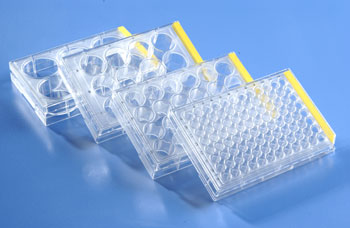Cell culture involves isolation of cells from an animal, or plant and culturing in a dish in a favorable growth conditions for the cells. Cells can be isolated from a tissue including human normal or tumor origin by enzymatic digestion or mechanical means to obtain single or multicellular population for subsequent culture. Cell culture can also mean culturing cells derived from a cell line, which was previously established.
Cell culture can be primary or a cell line. If the cells are isolated from a tissue and grown in a culture vessel in its growth medium until they grow to confluence (almost full capacity of the space), these are primary cell culture. After the cells reach confluence, they will be subcultures by taking an aliquot of these cells and culturing in another vessel to grow with fresh medium and nutrients. This will be called passaging the cells. It is important to keep track of the passage number (how many times the cells are divided and sub cultured), because the higher the passage number, less likely the cells will have the original characteristics. For example: if you culture primary endothelial cells and passage them several times, they will loose the endothelial phenotype, and characteristics. If it is important to conduct important studies with endothelial cells, it is important to do them while the cells are at lower passage number while they have the characteristics of the endothelial cells. At lower passage number, endothelial cells look more like cobblestone. As the passage number get higher, they become elongated more like fibroblasts.
In the case of tumor cell lines, they can be sub cultured more than primary culture without loosing original characteristics. Tumor cell lines are relatively easy to culture compared to primary cell lines. Primary cell lines typically grow slow, and may require culture flask or plate be coated with extracellular matrix proteins such as collagen, or fibronectin. Normal cells can divide only a limited number of times, which is genetically programmed. However some cells become immortal through transformation, which can be induced chemically or virally induced.
Culture conditions
Culture conditions are different for different cell type. Primary cells may need specific nutrients for their growth, which can be hormones, growth factors, and substrate of the cell culture flask or multiwell plate. Cell lines typically grow fast, and easier to grow than the primary cells. All of them grow in 5% CO2 at 37 0C temperature with humidity. Cells are grown in incubators maintaining the right amount of CO2, temperature and humidity. If these conditions are not kept at consistent levels, the cells may not grow optimally. Most of the cell types are anchorage dependent and must be attached to a solid or semi sold substrate also called adherent or monolayer culture. The other type of cells can be grown in suspension (suspension culture).

